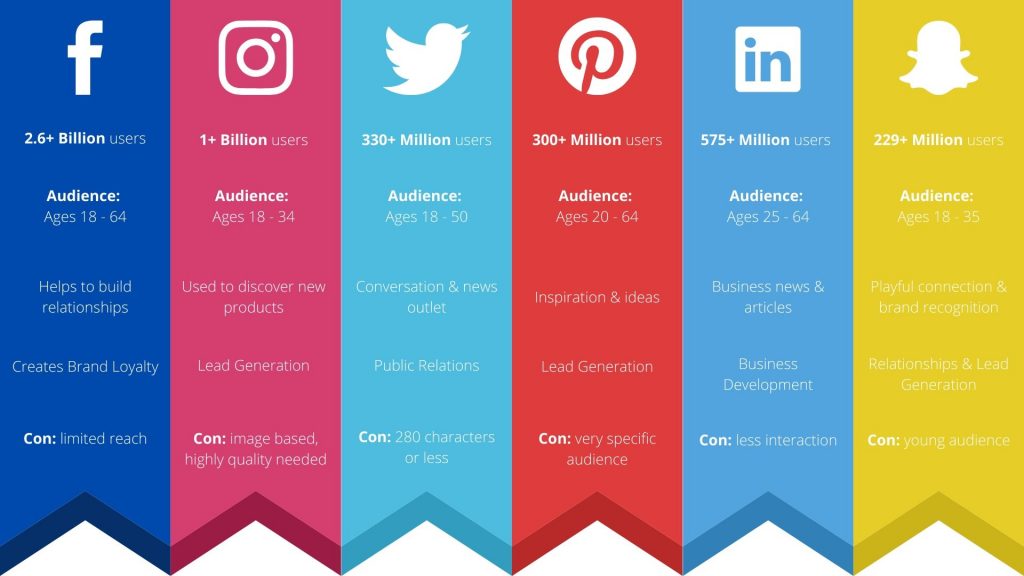Social Media is one of the cheapest marketing channels for a business, not to mention the ROI is growing every day. If that’s not enough to motivate you to up your social game, then we don’t know what is.
Social media is incredibly important for your brand. So, let’s jump in and discuss some of the most popular social media platforms and which ones may, or may not, be the best for your business.
With so many socials media channels out there, figuring out which ones can benefit your business the most can be difficult. For example, what works on Twitter will not perform well on Instagram. Putting your attention on just a few social platforms is the best option, especially if you’re just in the beginning stages of social media! This will help you to really nail down your social strategy and get the best return on your investment (whether that is actual monetary investment, or simply the time it takes to create content and manage your profile(s) well.)
So how do you choose the right platforms for you?
There are a few things you need to think about first. Who is your audience? I know, I know — we say this all the time, but if you don’t know who your audience is, then how can you sell to them?
That brings me to the next item. Once you’ve determined your audience, you need to think about what your goals are for social media (I’ll describe this more later).
And the last question you need to answer is “where can I find my audience?”
Now while you have these questions in the back of your mind, let’s take a look at key aspects of some of the most popular social channels:

Keep in mind there are many other popular social platforms and some of them may work for you! For example YouTube, TikTok, Google+, etc. With these basic guidelines we have given you, you should be able to go out and do some quick and simple research to determine if any other platforms are right for you. (Pro tip: Just because you don’t have a profile does not mean you can’t reach your audience on them. Advertising is always available to you!)
Who is your audience?
The more demographics and details you can pull together on your audience, the better. It becomes much easier to reach your audience as your understanding of your audience grows.
If you have a website, read this post about finding your web audience. It’s a great place to start!
When defining your audience, try to answer these important questions:
- How would you describe your typical customer?
- What is the age range of most of your customers?
- Are your customers mostly male or female? Or both?
- What is their income? Highest level of education?
- What’s their lifestyle? Behaviors? Interests?
Use these to help build a profile of your audience.
What are your goals?
Now that you have your audience, what are your goals for this audience on social media? You may think the answer to this question should be simple — to drive sales; but, there are a variety of goals you can have for social media. You can drive brand recognition, form relationships with potential customers, use it as a channel for customer support…the list goes on!
Try to consider what will work best for your business and then come up with a few solid goals for your social media platforms. They can be a mix of unusual/creative goals and more typical business goals that many would have.
What platforms will help you reach your audience?
Take a look back at that chart above. How does your audience best fit in there? Will that platform help you reach your goals?
Have a few in mind? Now let’s think about it from a content-based perspective.
Curation
Do you have an active website? Maybe even a blog on your site? If you have a lot of articles and content and plan to share links on social often, then Twitter and Facebook are good platforms to utilize. They show thumbnails and snippets of the article to really encourage engagement, including sharing the articles. If you are a B2B business, consider using LinkedIn to create more connections.
Business News & Happenings
It’s always a good idea to keep your audience updated on what your business is doing. Once again, Facebook, Twitter & LinkedIn can be great for content-heavy posts such as events and company projects. Another option is Instagram and the Stories feature. It’s a great way to share glimpses of projects, teasers, and fun videos, etc.
Pictures
Images could possibly be the most important portion of any social post. Many social media users don’t waste time reading in order to find out what your message is for a post. They want to get the information quickly, so pictures are ideal. Instagram, Pinterest, and even Snapchat are great for photos. These platforms are very photo-oriented. However, all the popular social platforms support photos, so you really can’t go wrong.
Videos
As we’ve said a million times before, video is the king of social media these days. Video truly is the best way to reach more people and keep your audience engaged. It comes to no surprise that most of the big social platforms are optimized for video. Facebook, Instagram, Snapchat, and of course YouTube are ideal for video but don’t think you’re limited to just those. Twitter, LinkedIn, and many other platforms also support video.
Brand Recognition
Once again, great visuals such as photos and videos are great for branding on social media. Just keep in mind your content will differ between platforms. With that said, Instagram and Snapchat are great for getting brand recognition because they have very highly engaged users.
Lead Generation
Instagram and Pinterest are great social channels for lead generation. Many of these users are engaged shoppers and use the platforms to plan purchases Although, the clear front-runner for B2B lead generation is LinkedIn.
__________________
This can be a lot of information to take in at once, but just start slow and focus on two or three channels. Try to do what will work best for your business. You can start to expand once you are comfortable with those channels and start to see growth.
If this helped you decide what the best social platforms are for your business, but you don’t have the time to manage your accounts, contact us! We’d love to help.




